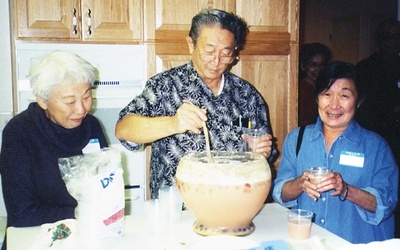
Iku Kiriyama
Retired LAUSD educator. Community volunteer. Iku does various presentations and programs. (Photo courtesy of Densho)
Updated January 2015
Stories from This Author
A Good Friend and a Good Neighbor
Nov. 27, 2018 • Iku Kiriyama
With the passing of Wakako Yamauchi, we have lost another community icon. In 1995, my late husband, George, and I bought a home in Gardena. He had just been elected to the Los Angeles Unified School Board, and we had to reside in the district. It turned out Wakako lived a few doors down across the street. We became fast friends. Wakako would go with us downtown to community events, to East West Players’ performances … until she and EWP …
Sugi Kiriyama, A Typical Issei Woman
July 8, 2015 • Iku Kiriyama
Issei are identified with similar characteristics that Nisei would concur: came to this country with no English skills, no money, dreams of success and possibly returning to Japan. They were hard-working, endured racism and physical abuse, lived through the Great Depression and the injustice of the World War II concentration camps, and bore hardships for the sake of their children, the Nisei, born here in the United States. The Issei woman was all the above, plus being the smiling, doting …
Legacies
June 19, 2015 • Iku Kiriyama
For Japanese Americans of my generation (second generation Nisei over 60), the source of our moral and cultural values is both clear and easily defined. Our moral and cultural values spring from the Japanese cultural heritage of our parents and grandparents. If a group of Nisei, unacquainted with each other, were to gather in a room and a discussion arose about our childhood days, you would find an instant bond as the sharing of stories showed common stories of Issei …
A Typical Story of Survival & Regrowth After the War
April 16, 2015 • Iku Kiriyama
Takashi and Shizuko (nee: Mori) Kato and their two children, Roy Shigehisa and Ikuko, moved from Inglewood to West Los Angeles just prior to evacuation to Manzanar. They left everything behind with their lost nursery business; the property had been taken over by the U.S. Army apparently because of its proximity to LAX and used to encamp soldiers. That was their first experience with camouflage nets and guns surrounding them—and earned them a picture of their invasion of privacy in …
Haru Hashimoto: Matriarch of Mikawaya
Feb. 2, 2015 • Iku Kiriyama
Haru Hashimoto was born on July 10, 1903, in Japan, Aichi-ken, Nakashima-gun, Heiwa-mura, to Manjiro and Masa Kataoka. She was the second of six children. She came to San Francisco via Hawaii by ship on January 10, 1923, as a young 19-year-old bride of Koroku Hashimoto (born Meiji-33, June 22), whose marriage on December 9, 1922 was arranged in the traditional omiai by a baishakunin (go-between, also called nakodo). Koroku had returned to Japan when rumors of the 1924 Exclusion …
“RING, RING”
Jan. 14, 2015 • Iku Kiriyama
A phone call redirected my career and changed my life forever. Dr. Theodore Chen, chair of the East Asian Studies Department, was on the other end of the line that day in the spring of 1963. He told me the University of Southern California (USC) had received a grant from the Carnegie Foundation to pilot a Japanese language program for the Los Angeles Unified School District. He knew me from my college days at USC where I was active in …









